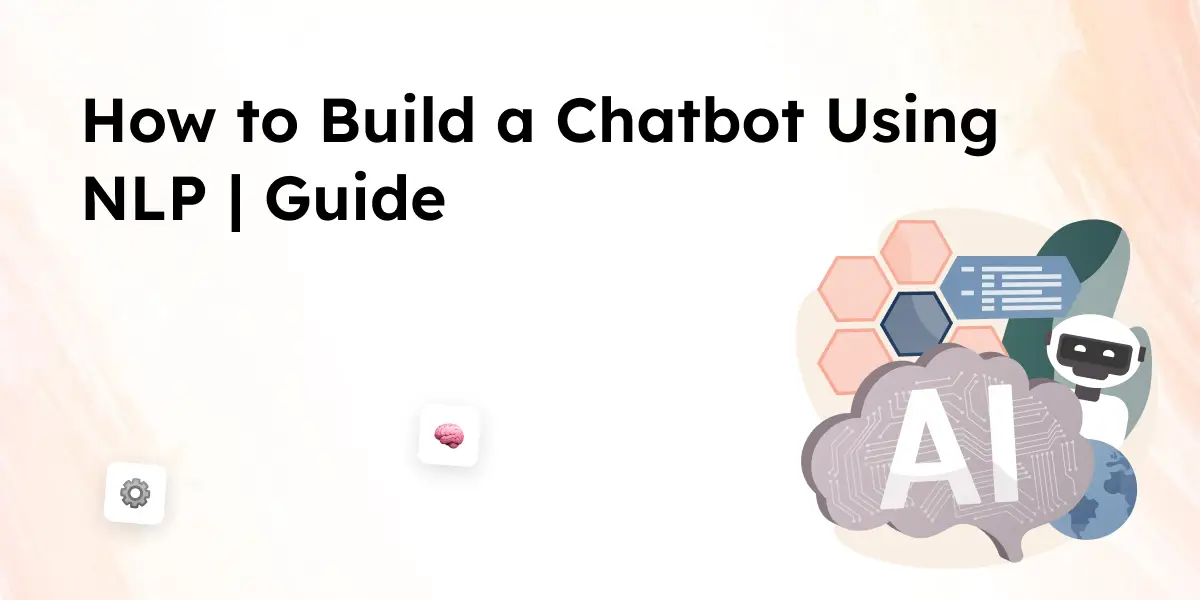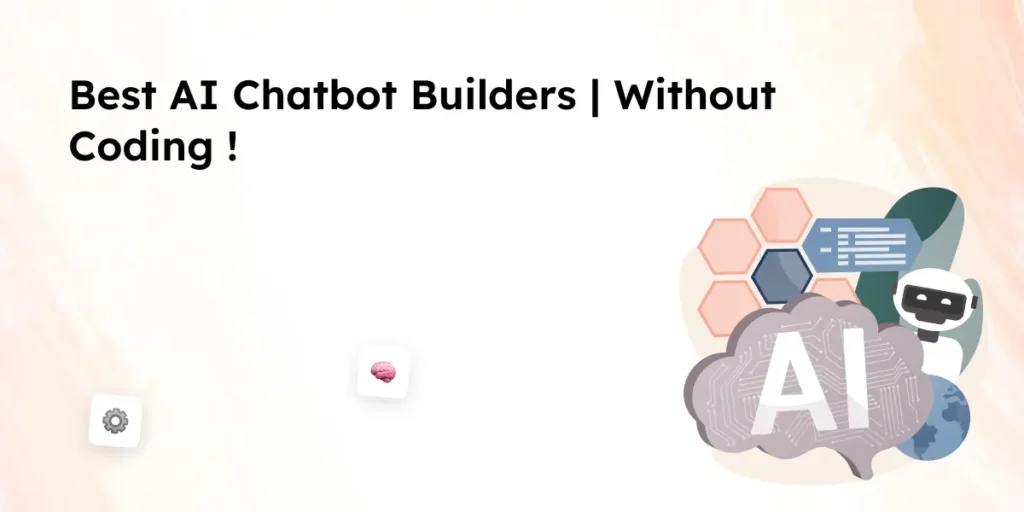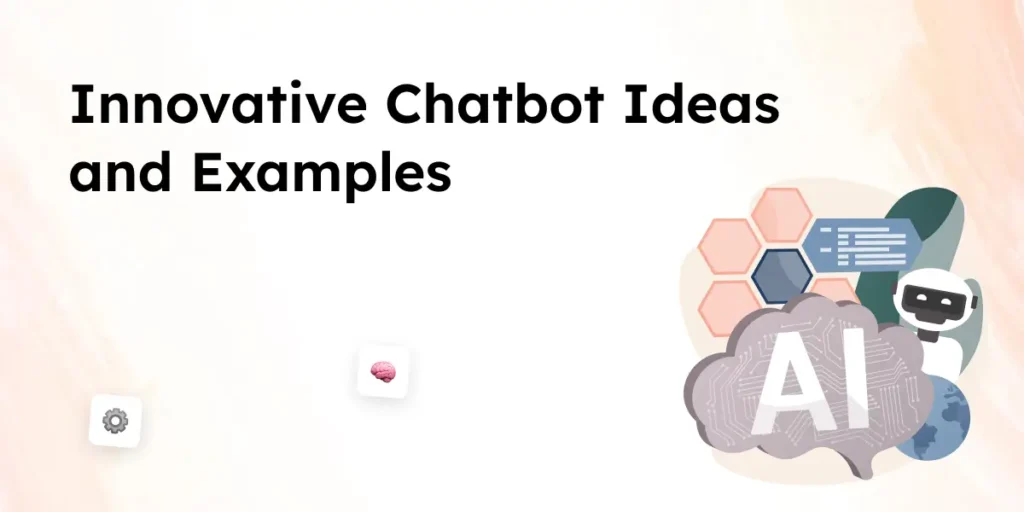Building a chatbot using nlp allows businesses to automate customer interactions and handle user input efficiently. Nlp, a branch of artificial intelligence, helps chatbots understand human language and respond naturally. Ai chatbots are widely used in customer support, e-commerce, and SaaS, improving response accuracy and reducing workload. This step-by-step guide will cover chatbot development, nlp algorithms, and practical implementation, helping you create an nlp chatbot from scratch.
Understanding Natural Language Processing (NLP)
Nlp allows chatbots to understand human language and respond naturally. It is a branch of artificial intelligence that focuses on the interaction between computers and humans using natural communication. By using natural language processing, chatbots can analyze user input, recognize intent, and generate appropriate responses.
Key Components of NLP in Chatbots
- Tokenization – Breaks sentences into words or phrases for better text processing.
- Stemming and Lemmatization – Reduces words to their base forms to understand variations in language.
- Named Entity Recognition (NER) – Identifies key elements like names, dates, and locations in text.
- Intent Recognition – Determines the purpose behind user input to provide relevant responses.
- Sentiment Analysis – Detects the emotional tone behind a message, helping chatbots adjust their responses.
How NLP Enhances Chatbot Development
- Processes and understands the context of conversations using advanced nlp algorithms.
- Utilizes deep learning and machine learning for continuous improvement and accurate responses.
- Helps chatbots detect user intent and extract relevant details from conversations.
- Supports chatbot integration with customer support platforms, making interactions more efficient.
- Enables chatbots to respond to natural language queries, improving user experience.
Why Businesses Use NLP Chatbots
- Reduces repetitive tasks by automating responses to common customer queries.
- Enhances chatbot technology to provide more human-like interactions.
- Works across various chatbot platforms, including SaaS and e-commerce applications.
- Improves accuracy through model training, making the chatbot more reliable over time.
- Supports popular chatbot development frameworks, helping businesses build a chatbot tailored to their needs.
Benefits of NLP Chatbots in Customer Support
Nlp chatbots are transforming customer support by automating responses and improving efficiency. Businesses dealing with high volumes of user input can benefit from ai chatbots that handle repetitive queries, allowing support teams to focus on more complex issues. Using natural language processing, chatbots understand and respond to natural language, making interactions smoother and more effective.
Reduces Support Ticket Volume
- Chatbots with nlp handle tier-1 support inquiries, minimizing the need for human intervention.
- Helps your chatbot respond instantly to frequently asked questions, reducing customer wait times.
Improves Customer Satisfaction
- Ai chatbots provide 24/7 availability, ensuring customers get answers anytime.
- Respond to natural language queries accurately, making conversations feel more human.
Enhances Efficiency for Support Teams
- Allows the chatbot to take care of repetitive inquiries, freeing up human agents for complex issues.
- Chatbot development ensures seamless integration with existing support systems, reducing workflow disruptions.
Ensures Consistent and Accurate Responses
- Model training helps chatbots improve over time by learning from past interactions.
- Various nlp algorithms are used to refine responses, making ai chatbots more reliable.
Supports Multi-Channel Communication
- Chatbot technology can be deployed across websites, messaging apps, and email systems.
- Chatbots with nlp work on different chatbot platforms, ensuring flexibility for businesses.
Reduces Operational Costs
- Ai chatbots help businesses cut costs by reducing the need for large customer support teams.
- Chatbot needs minimal maintenance once trained properly, making it a cost-effective solution.
Nlp chatbots are becoming essential in industries that require fast, accurate, and scalable customer support. By leveraging ai and machine learning, businesses can improve customer experiences while optimizing resources.
Getting Started: Tools and Technologies
To build a chatbot using nlp, choosing the right tools and technologies is essential. Various chatbot platforms, nlp engines, and machine learning frameworks help businesses create an ai chatbot that understands user input and responds accurately. From simple chatbot development to advanced ai chatbots, selecting the right technology stack ensures efficiency and scalability.
Programming Languages for Chatbot Development
- Python – The most widely used language for chatbot development due to its extensive nlp libraries.
- JavaScript – Commonly used for web-based chatbots and integrations with messaging platforms.
- Java – Suitable for enterprise chatbot solutions requiring robust performance.
Popular NLP Libraries and Frameworks
- NLTK (Natural Language Toolkit) – A comprehensive library for natural language processing in python.
- spaCy – A fast and efficient nlp library used for tokenization, named entity recognition, and deep learning models.
- Transformers by Hugging Face – Used in ai chatbots to implement generative ai applications and train the chatbot for improved response accuracy.
Chatbot Development Platforms
- Dialogflow – A chatbot platform by Google that supports nlp and integrates with various applications.
- Rasa – An open-source nlp chatbot framework for building advanced ai agents.
- Microsoft Bot Framework – Allows businesses to create a chatbot with nlp capabilities and integrate it into Microsoft services.
Machine Learning and Deep Learning Technologies
- TensorFlow – Used for training an ai chatbot with deep learning models to improve understanding of user input.
- PyTorch – Helps build ai chatbots that use machine learning for real-time interactions.
- Vertex AI – A cloud-based ai platform by Google for developing and deploying machine learning models.
Data Requirements for Training a Chatbot
- Collecting real conversations – Data to train a chatbot should come from real customer interactions to improve accuracy.
- Labeling intents and responses – Ensures the chatbot understands context and user input correctly.
- Model training and evaluation – Allows the chatbot to improve response accuracy over time.
Using chatgpt and other generative ai models, businesses can develop a chatbot that improves interactions with customers. The right nlp technology and chatbot platforms help ensure the chatbot is an ai-powered software that enhances support operations.
Step-by-Step Guide to Building an NLP Chatbot
Developing a chatbot using nlp involves multiple steps, from defining its purpose to training it to understand human language. This section provides a step-by-step guide to help businesses build ai chatbots that improve customer interactions and automate repetitive tasks.
1. Defining Objectives and Scope
- Identify the chatbot needs, such as handling customer support queries or providing product recommendations.
- Determine the chatbot platform that best fits the business, whether it’s a website, messaging app, or voice assistant.
- Set performance goals, such as response accuracy and integration with existing systems.
2. Data Collection and Preparation
- Gather real-world conversations to train the chatbot with accurate responses.
- Clean and preprocess the data using natural language processing to remove noise and improve text quality.
- Label user intents and responses to help the chatbot understand the context of queries.
3. Designing the Conversation Flow
- Map out potential user interactions to create a chatbot that guides users through logical conversation paths.
- Define fallback responses to ensure the chatbot stays on track when it encounters unfamiliar input.
- Consider chatbot personality to make interactions more engaging.
4. Implementing NLP Techniques
- Use nlp algorithms like tokenization, stemming, and named entity recognition to process user input.
- Apply sentiment analysis to adjust responses based on user emotions.
- Develop an nlp model that allows the chatbot to detect intent and generate appropriate replies.
5. Training the Chatbot
- Train the chatbot using machine learning models, deep learning networks, or generative ai techniques.
- Fine-tune responses using reinforcement learning and model evaluation metrics.
- Ensure the chatbot understands natural language queries by testing against diverse user inputs.
6. Testing and Refinement
- Conduct user testing to see how well the chatbot with nlp performs in real-world scenarios.
- Use feedback to improve chatbot responses and enhance its natural language understanding.
- Ensure the chatbot can be a fun and helpful tool by continuously updating and improving its nlp engine.
This approach to chatbot development helps businesses build a chatbot from scratch while leveraging ai technology to improve interactions. By training an ai chatbot properly, it can effectively understand and respond to natural language, making it a valuable tool for customer support and engagement.
Monitoring Performance and Continuous Improvement
Once a chatbot using nlp is deployed, monitoring its performance is essential to ensure it continues to understand user input and provide accurate responses. Regular updates and improvements help businesses optimize their chatbot technology for better efficiency.
1. Tracking Key Performance Metrics
- Response Accuracy – Measure how well the chatbot understands natural language and provides relevant answers.
- Resolution Rate – Track the percentage of inquiries resolved without human intervention.
- User Satisfaction – Collect feedback from users to determine how effective the chatbot is in assisting them.
- Conversation Drop-off Rates – Identify where users abandon conversations and improve those interactions.
2. Enhancing NLP Model Performance
- Train the chatbot continuously with new data to improve accuracy.
- Refine the chatbot’s responses by updating the nlp model based on real-world interactions.
- Use various nlp techniques like sentiment analysis and entity recognition to enhance conversational ai capabilities.
- Ensure the chatbot stays up to date by regularly incorporating new user queries and business-related updates.
3. Addressing Common Chatbot Challenges
- Handling ambiguous queries – Improve the chatbot with nlp by training it to ask clarifying questions when uncertain.
- Avoiding incorrect responses – Use reinforcement learning to adjust the chatbot’s answers based on past mistakes.
- Ensuring the chatbot understands human language nuances – Implement deep learning models for improved comprehension.
- Improving your chatbot by testing frequently – Regular A/B testing helps determine what works best in real conversations.
By continuously monitoring and refining the chatbot, businesses can ensure the chatbot is an ai-powered software that enhances customer interactions. The right combination of nlp algorithms, machine learning models, and chatbot development strategies can significantly improve chatbot performance over time.
Challenges in NLP Chatbot Development
Building a chatbot using nlp comes with challenges that can impact performance and user experience. Understanding these challenges and applying best practices ensures that ai chatbots provide accurate and engaging responses.
Understanding User Intent
- Chatbots with nlp sometimes struggle to understand complex or ambiguous user input.
- Training an ai chatbot with diverse data helps it recognize different ways users ask the same question.
Handling Multiple Languages and Dialects
- Natural language processing must adapt to different languages and slang.
- Using deep learning techniques improves the chatbot’s ability to understand human language variations.
Maintaining Context in Conversations
- Chatbot development should focus on ensuring conversations feel natural and connected.
- An nlp engine must track previous user input to keep conversations flowing logically.
Avoiding Incorrect or Irrelevant Responses
- Ai chatbots sometimes generate responses that don’t make sense.
- Continuous model training and user feedback help improve chatbot accuracy.
Best Practices for Building Effective NLP Chatbots
Use High-Quality Training Data
- Data to train a chatbot should come from real interactions to improve accuracy.
- Labeling data properly helps the chatbot understand the context better.
Regularly Update and Improve the Chatbot
- Nlp chatbots require constant learning to adapt to new trends and customer queries.
- Updating chatbot responses and retraining models enhances performance.
Ensure Smooth Integration with Support Systems
- Chatbot platforms like Zendesk and Salesforce should work seamlessly with ai chatbots.
- An effective chatbot with nlp integrates well with CRM and help desk tools.
Balance Automation with Human Assistance
- The chatbot should recognize when human intervention is needed.
- Using a hybrid model where ai chatbots handle simple queries while humans manage complex issues improves customer support.
Measure and Optimize Performance
- Monitoring chatbot analytics metrics like response time and accuracy ensures better performance.
- Running A/B tests helps businesses develop a chatbot that continuously improves over time.
Nlp and chatbots are evolving, and applying best practices ensures businesses get the most out of ai chatbots. With proper chatbot development, machine learning models, and continuous monitoring, businesses can build ai chatbots that enhance customer experience and streamline support operations.
Conclusion
Building a chatbot using nlp allows businesses to automate interactions, reduce support workload, and improve customer experience. Ai chatbots powered by natural language processing can understand user input, respond accurately, and integrate seamlessly with existing support systems.
The development process involves defining chatbot needs, selecting the right chatbot platform, training an nlp model, and continuously improving chatbot responses. Businesses can enhance chatbot technology by leveraging deep learning, machine learning, and nlp algorithms to refine chatbot interactions over time.
Monitoring chatbot performance ensures that the chatbot stays effective and continues to respond to natural language queries accurately. Regular updates, model training, and user feedback help businesses optimize chatbot development and maintain high response accuracy.
FAQ: Common Questions About NLP Chatbots
1. What is an NLP chatbot?
An nlp chatbot is an ai-powered software that understands and responds to user input using natural language processing. It can analyze text, detect intent, and generate relevant replies, making interactions feel more human-like.
2. How does NLP help chatbots understand human language?
Nlp allows chatbots to break down text using techniques like tokenization, named entity recognition, and sentiment analysis. These methods help the chatbot understand context and respond appropriately.
3. What are the best tools to build a chatbot using NLP?
Popular tools for chatbot development include:
Python for programming the chatbot
NLTK and spaCy for nlp processing
Dialogflow and Rasa for chatbot platform integration
TensorFlow and PyTorch for deep learning enhancements
4. How can businesses use NLP chatbots?
Businesses use ai chatbots for customer support, sales automation, and answering frequently asked questions. Chatbots help reduce response times, improve efficiency, and provide 24/7 support.



